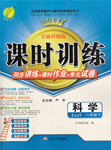题目内容
B. when
C. how
D. where

 课时训练江苏人民出版社系列答案
课时训练江苏人民出版社系列答案 黄冈经典趣味课堂系列答案
黄冈经典趣味课堂系列答案 启东小题作业本系列答案
启东小题作业本系列答案Sitting on a chair all day in school can make anyone want to move around. So, more and more teachers are letting students have a ball. By sitting on exercise balls instead of chairs, teachers find students' posture (姿势) and attention improve.
Dottie Pownall, a fifth-grade teacher in West Virginia, USA, has been using balls as chairs since December 2008. "The students love them", she says. Pownall took a survey of her students. She found that 80% of the students thought sitting on the balls helped them pay more attention to what they were learning.
The teacher, Pisa Witt, felt so strongly about the use of balls as chairs, she started Witt Fitt. This company encourages the use of the balls. And the company educates not only teachers but also students on how to use them. "Our products are used in 24 states, three provinces in Canada, Puert o Rico ('波多黎各) and Japan," says Witt. "Research shows that sitting on the balls makes them sit up straighter. You can slouch (低头垂肩地坐) on a ball," says Witt, "but it feels awful." Because the students are moving, their blood (血液) increases. That carries more oxygen (氧气 to the brain (大脑), so the kids have more energy and can focus longer.
o Rico ('波多黎各) and Japan," says Witt. "Research shows that sitting on the balls makes them sit up straighter. You can slouch (低头垂肩地坐) on a ball," says Witt, "but it feels awful." Because the students are moving, their blood (血液) increases. That carries more oxygen (氧气 to the brain (大脑), so the kids have more energy and can focus longer.
"Furthermore, they're fun." says Pownali.
【小题1】 What will happen if a student sits on a chair all day in school? The student will _________.
| A.pay more attention to his lessons | B.be fun |
| C.like to move around | D.sit up straighter |
| A.About three years. | B.Only one year. |
| C.In 2008. | D.Since he was a fifth-grade teacher. |
| A.Four. | B.Three. | C.Two. | D.One. |
| A.improve the students' posture and attention | B.slouch on the chairs |
| C.have fun | D.Both A and C are correct answers. |
| A.Sitting on a chair. | B.Sitting on a ball. |
| C.They are the same. | D.We don't know. |
Mrs. Clark moved to the small village when she was twenty-four. And she has lived there for thirty-nine years. She has a poor farm. She works hard on it, but she is often hungry. Her son Henry joined the army(参军) eight years ago and then found a job at a post office in London after he left the army.
One day, he wrote to his poor mother and asked her to go to the capital. The old woman was very happy when she received the letter. The next morning she started. Because it was the first time, her daughter took her to a small station and bought a ticket for her. A train came and she hurried to get on. Before long, a conductor came up to her and said, ‘Ticket, please.’ The old woman showed her ticket to the conductor. The man looked at it and said, ‘You must take a train to London. But it is a train to Manchester. I am afraid you’ve taken a wrong train.’ ‘Is it possible?’ Mrs. Clark said angrily, ‘I am sure it’s your driver’s fault (过错).
【小题1】Mrs. Clark is __________ years old now.
B.thirty-nine
C.sixty-three
D.eighty
【小题2】The old woman took a wrong train because _______________
| A.she had never taken a train before. |
| B.her daughter took her to a wrong train. |
| C.she never visited Manchester and she wanted to go there. |
| D.the driver is silly (愚蠢) and it was his fault. |
| A.司机 |
| B.售票员 |
| C.检票员 |
| D.乘警 |
| A.Mrs. Clark took a wrong train. |
| B.The driver drove to a wrong place. |
| C.Mrs. Clark’s daughter bought a right ticket for her mother. |
| D.The conductor wanted to see Mrs. Clark’s ticket. |
When Susan told me that she was terribly ill and probably would die. I cried. I didn’t understand why this happened to my best friend. Then Susan 35 me a red ribbon(丝带) without saying anything.
A month later, Susan was at a hospital about two hours away from where we lived. I asked my dad to take me to see her. I wanted to give my best friend a 36 . So I took out the ribbon and cut it into two pieces with scissors(剪刀). I put one in my pocket and the other in an envelope(信封), along with a letter explaining it to her. I told her to keep her 37 beside her bed, and I would keep mine near me, too. Then I went to the hospital one Friday afternoon, wondering (想知道) if the ribbon would 38 anything to her. I walked into the room and ran over to give her a big hug. Then I gave her a teddy bear and the envelope. We talked for a while and then she started looking 39 , so I asked her to get some rest and left the hospital. All the way home I 40 the ribbon close to me.
For the next four months, the ribbon was with me 41 I went: school, home, shopping, and at friends’ houses. Where I went, it went. It was something to remind(提醒)me that I had a friend who would 42 home very soon. Susan said that she wore her ribbon 43 her arm all the time and she always had it close to her when she was being tested and treated.
Finally, Susan came home! I was so happy. That night, I looked at the ribbon which was still with me. I had a feeling it would never 44 , that I would remember what had happened during the time she had been ill.
|
1. |
|
|
2. |
|
|
3. |
|
|
4. |
|
|
5. |
|
|
6. |
|
|
7. |
|
|
8. |
|
|
9. |
|
|
10. |
|